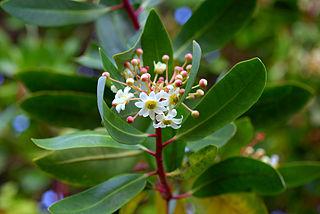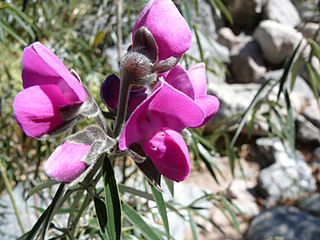
Phaseolus is a genus of herbaceous to woody annual and perennial vines in the family Fabaceae containing about 70 plant species, all native to the Americas, primarily Mesoamerica.

Vigna is a genus of plants in the legume family, Fabaceae, with a pantropical distribution. It includes some well-known cultivated species, including many types of beans. Some are former members of the genus Phaseolus. According to Hortus Third, Vigna differs from Phaseolus in biochemistry and pollen structure, and in details of the style and stipules.

Chusquea is a genus of evergreen bamboos in the grass family. Most of them are native to mountain habitats in Latin America, from Mexico to southern Chile and Argentina.

Psidium is a genus of trees and shrubs in the family Myrtaceae. It is native to warmer parts of the Western Hemisphere. Many of the species bear edible fruits, and for this reason several are cultivated commercially. The most popularly cultivated species is the common guava, Psidium guajava.

Drimys is a genus of seven species of woody evergreen flowering plants, in the family Winteraceae. The species are native to the Neotropics, ranging from southern Mexico to the southern tip of South America. They are primitive dicots, associated with the humid temperate Antarctic flora of the Southern Hemisphere, which evolved millions of years ago on the ancient supercontinent of Gondwana. Members of the family generally have aromatic bark and leaves, and some are used to extract essential oils.

The plant tribe Phaseoleae is one of the subdivisions of the legume subfamily Faboideae, in the unranked NPAAA clade. This group includes many of the beans cultivated for human and animal food, most importantly from the genera Glycine, Phaseolus, and Vigna.

Pouteria is a genus of flowering trees in the gutta-percha family, Sapotaceae. The genus is widespread throughout the tropical Americas, with outlier species in Cameroon and Malesia. It includes the canistel, the mamey sapote, and the lucuma. Commonly, this genus is known as pouteria trees, or in some cases, eggfruits.

Collaea is a genus of flowering plants in the legume family, Fabaceae. It belongs to subfamily Faboideae and tribe Diocleae. It includes five species native to the southern tropical South America, ranging from Peru to northeastern Brazil and northeastern Argentina.
Condylostylis is a small genus of flowering plants in the legume family, Fabaceae. It belongs to subfamily Faboideae. The genus includes four species native to the tropical Americas, ranging from southeastern Mexico to northern Argentina. Species in this genus were formerly considered to belong to the genus Vigna.
Dolichopsis is a small genus of flowering plants in the legume family, Fabaceae. It belongs to the subfamily Faboideae. It includes three species native to South America, ranging from west-central and southeastern Brazil to Bolivia, Paraguay, and northern Argentina.

Leptospron is a small genus of flowering plants in the legume family, Fabaceae. It contains two species with a pantropical distribution. It belongs to the subfamily Faboideae. Species in this genus were formerly considered to belong to the genus Vigna.
Mysanthus uleanus is a species of flowering plant in the legume family, Fabaceae. It is a climbing herb endemic to eastern Brazil. It grows in seasonally-dry tropical wooded grassland, thorn scrub, rocky shrubland, and in degraded areas. It is the only described member of the genus Mysanthus, though there is a report of an undescribed species. The genus belongs to subfamily Faboideae.

Oxyrhynchus is a small genus of flowering plants in the legume family, Fabaceae. It includes four species, three native to the tropical Americas from northern Mexico to Colombia, and one native to New Guinea, Maluku, and the Bismarck Archipelago. It belongs to the subfamily Faboideae. A key for the species in this genus has been published.

Sigmoidotropis is a genus of flowering plants in the legume family, Fabaceae. It includes eight species native to the tropical Americas, ranging from northern Mexico and the Caribbean islands to southern Brazil. It belongs to the subfamily Faboideae. Species in this genus were formerly considered to belong to the genus Vigna.

Picramniaceae is a small, mainly neotropical family of four genera Aenigmanu, Alvaradoa, Nothotalisia and Picramnia. The family is the only member of the order Picramniales. Members of the family were formerly placed in the family Simaroubaceae or misidentified as species in the family Sapindaceae, in the order Sapindales. The most recent standard classification of the Angiosperms distinguishes it as a separate family and order. It belongs to the malvids, one of the three groups that constitute the rosids.

Gamochaeta is a genus of flowering plants in the family Asteraceae. There has not always been agreement among botanists regarding its status as a recognized genus, but it has become more accepted in recent years. It currently includes many plants that previously belonged in genus Gnaphalium. Like many species of Gnaphalium, many Gamochaeta are called cudweeds or everlastings.

Ancistrotropis is a genus of flowering plants in the legume family, Fabaceae. It belongs to the subfamily Faboideae. Species in this genus were formerly considered to belong to the genus Vigna.

Ramirezella is a small genus of flowering plants in the family Fabaceae. It includes seven species of climbing herbs native to southern North America, ranging from northern Mexico and Nicaragua. Typical habitats include seasonally-dry tropical forest and secondary vegetation in disturbed areas. It belongs to the subfamily Faboideae.

Wajira is a small genus of flowering plants in the legume family, Fabaceae. It includes five species of climbing herbs or subshrubs native to tropical Africa, the Indian subcontinent, and Thailand. Four species are native to the Somali-Masai region of northeastern tropical Africa. Wajira grahamiana is more widespread in Africa and ranges to the Indian subcontinent and Indochina. Typical habitats are seasonally-dry tropical forest, woodland, bushland, and grassland. It belongs to the subfamily Faboideae. Species in this genus were formerly considered to belong to the genus Vigna. A key for the genus has been published.















